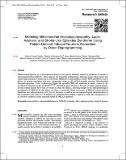Por favor, use este identificador para citar o enlazar a este item:
http://hdl.handle.net/10261/296089COMPARTIR / EXPORTAR:
 SHARE SHARE
 CORE
BASE CORE
BASE
|
|
| Visualizar otros formatos: MARC | Dublin Core | RDF | ORE | MODS | METS | DIDL | DATACITE | |

| Título: | Modeling mitochondrial encephalomyopathy, lactic acidosis, and stroke-like episodes syndrome using patient-derived induced neurons generated by direct reprogramming |
Autor: | Povea-Cabello, Suleva; Villanueva-Paz, Marina CSIC ORCID; Villalón-García, Irene; Talaverón-Rey, Marta; Álvarez-Córdoba, Mónica; Suarez-Rivero, Juan M. CSIC ORCID; Montes, María Ángeles; Rodríguez-Moreno, Antonio CSIC ORCID; Andrade-Talavera, Yuniesky; Armengol, José Ángel; Sánchez-Alcázar, José Antonio CSIC ORCID | Palabras clave: | Mitochondria Mitochondrial diseases MELAS syndrome Direct reprogramming Induced neurons |
Fecha de publicación: | 7-oct-2022 | Editor: | Mary Ann Liebert | Citación: | Cellular Reprogramming 24(5): 294-303 (2022) | Resumen: | Mitochondrial diseases are a heterogeneous group of rare genetic disorders caused by mutations in nuclear or mitochondrial DNA (mtDNA). These diseases are frequently multisystemic, although mainly affect tissues that require large amounts of energy such as the brain. Mutations in mitochondrial transfer RNA (mt-tRNA) lead to defects in protein translation that may compromise some or all mtDNA-encoded proteins. Mitochondrial Encephalomyopathy, Lactic Acidosis and Stroke-like episodes (MELAS) syndrome is mainly caused by the m.3243A>G mutation in the mt-tRNALeu(UUR) (MT-TL1) gene. Owing to the lack of proper animal models, several cellular models have been developed to study the disease, providing insight in the pathophysiological mechanisms of MELAS. In this study, we show a successful direct conversion of MELAS patient-derived fibroblasts into induced neurons (iNs) for the first time, as well as an electrophysiological characterization of iNs cocultured with astrocytes. In addition, we performed bioenergetics analysis to study the consequences of m.3243A>G mutation in this neuronal model of MELAS syndrome. | Versión del editor: | http://dx.doi.org/10.1089/cell.2022.0055 | URI: | http://hdl.handle.net/10261/296089 | DOI: | 10.1089/cell.2022.0055 | Identificadores: | doi: 10.1089/cell.2022.0055 issn: 2152-4971 e-issn: 2152-4998 |
| Aparece en las colecciones: | (CABD) Artículos (IBIS) Artículos |
Ficheros en este ítem:
| Fichero | Descripción | Tamaño | Formato | |
|---|---|---|---|---|
| Modeling Mitochondrial Encephalomyopathy_Povea_Postprint_Art2022.pdf | 671,87 kB | Adobe PDF |  Visualizar/Abrir |
CORE Recommender
SCOPUSTM
Citations
1
checked on 28-mar-2024
WEB OF SCIENCETM
Citations
1
checked on 27-feb-2024
Page view(s)
70
checked on 26-abr-2024
Download(s)
48
checked on 26-abr-2024
Google ScholarTM
Check
Altmetric
Altmetric
NOTA: Los ítems de Digital.CSIC están protegidos por copyright, con todos los derechos reservados, a menos que se indique lo contrario.
